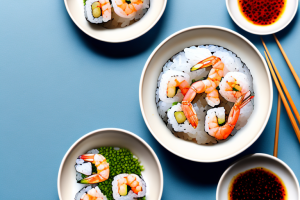How to prepare jasmine rice with Thai pineapple fried rice
9 min read
A bowl of jasmine rice with thai pineapple fried rice
Jasmine rice is an essential ingredient in Thai cuisine and pairs beautifully with the sweet and tangy flavors of pineapple, making it a perfect foundation for Thai pineapple fried rice. This article will guide you through everything you need to know about preparing this delicious and healthy dish.
The history of jasmine rice in Thai cuisine
Also known as ‘Hom Mali’ rice, jasmine rice is believed to have originated in Thailand more than 1500 years ago. The fluffy texture and fragrant aroma of jasmine rice make it a staple in Thai cuisine, and it’s often used to complement spicy and flavorful dishes. The price of jasmine rice has risen over recent years due to its popularity, as it’s now exported worldwide.
Thai farmers have been cultivating jasmine rice for generations, and it’s considered a symbol of Thai culture and identity. In fact, the Thai government has established strict regulations to ensure the quality and authenticity of jasmine rice, which is why it’s often labeled with the ‘Thai Hom Mali’ logo.
Aside from its culinary uses, jasmine rice also has cultural significance in Thailand. It’s often used in religious ceremonies and offerings, and is believed to bring good luck and prosperity. In addition, jasmine rice is a popular gift during special occasions such as weddings and housewarming parties.
Choosing the perfect jasmine rice for your fried rice recipe
When it comes to selecting the right jasmine rice for your Thai pineapple fried rice recipe, it’s essential to choose high-quality rice. Look for a brand that sources its jasmine rice from Thailand and has a reputation for supplying fresh and fragrant grains. Avoid purchasing jasmine rice that has been sitting on the shelf for more than six months, as the freshness and quality may have deteriorated.
Another important factor to consider when choosing jasmine rice for your fried rice recipe is the grain’s texture. Jasmine rice is known for its soft and fluffy texture, which makes it perfect for absorbing the flavors of the other ingredients in your fried rice. However, if you prefer a firmer texture, look for jasmine rice that has been aged for at least a year. This will give the rice a slightly firmer texture, which can be ideal for certain types of fried rice recipes.
The health benefits of jasmine rice and pineapple
Jasmine rice is an excellent source of complex carbohydrates, which helps to fuel your body and keep you energized. It’s also low in fat and has a low glycemic index, making it a healthy choice for people watching their weight or blood sugar levels. Pineapple, a high-fiber fruit, contains enzymes that aid digestion and is rich in vitamins and minerals such as vitamin C and manganese. Combined with jasmine rice, pineapple makes a delicious and nutritious meal.
In addition to their individual health benefits, jasmine rice and pineapple also have a synergistic effect when consumed together. The high fiber content of pineapple helps to slow down the digestion of jasmine rice, which in turn helps to regulate blood sugar levels and prevent spikes in insulin. This makes the combination of jasmine rice and pineapple an ideal meal for people with diabetes or those looking to maintain stable blood sugar levels. Furthermore, the combination of sweet and savory flavors in this dish makes it a crowd-pleaser for all taste buds.
A step-by-step guide to cooking perfect jasmine rice
To achieve perfect jasmine rice for your Thai pineapple fried rice recipe, use the following method:
- Rinse one cup of jasmine rice in cold water until the water runs clear.
- In a pot, add the rinsed rice and two cups of water and bring to a boil.
- Reduce the heat and simmer, cover the pot and let the rice cook for 18-20 minutes.
- Turn off the heat and let the rice rest for 5-10 minutes before fluffing it with a fork.
It is important to note that the ratio of water to rice may vary depending on the brand of jasmine rice you are using. Some brands may require slightly more or less water, so it is always a good idea to check the package instructions before cooking. Additionally, for added flavor, you can substitute some of the water with coconut milk or chicken broth.
The secret to achieving fluffy and fragrant jasmine rice
The secret to achieving fluffy and fragrant jasmine rice is to use the right amount of water and to allow the rice to rest for a few minutes before fluffing it. Adding just enough water to cook the rice, rather than leaving it to soak, ensures that the rice won’t become too mushy and sticky. Allowing the rice to rest for a few minutes helps the grains to separate, making it easier to fluff and preventing clumps.
Another tip for achieving perfect jasmine rice is to rinse the rice thoroughly before cooking. This removes excess starch and any debris that may be present. Additionally, using a high-quality jasmine rice can make a big difference in the final result. Look for rice that is labeled as “new crop” or “recent harvest” for the best flavor and texture.
The best way to cut and prepare fresh pineapple for your fried rice
Cutting a pineapple can be intimidating, but with the right technique, it’s easy. To prepare a fresh pineapple for your Thai pineapple fried rice, follow these steps:
- Cut off the top and bottom of the pineapple.
- Stand the pineapple up on one of the flat ends and cut off the outer skin in a downward motion, using a sharp knife.
- Once you have removed all of the skin, cut the pineapple in half lengthwise and remove the hard core in the center.
- Chop the pineapple into small pieces and set aside for your fried rice recipe.
Did you know that pineapples are not only delicious, but also packed with nutrients? Pineapples are a great source of vitamin C, which helps boost your immune system and promote healthy skin. They also contain bromelain, an enzyme that aids in digestion and can reduce inflammation in the body. So not only will your Thai pineapple fried rice taste amazing, but it will also provide some great health benefits!
Exploring the flavors of Thai seasoning in pineapple fried rice
Thai seasoning is what gives pineapple fried rice its signature flavor. Typically, traditional seasoning includes garlic, onion, soy sauce, fish sauce, and chili. Experiment with different spice blends to suit your tastes, and don’t be afraid to add more or less of each ingredient to find the perfect flavor combination.
Another key ingredient in pineapple fried rice is the pineapple itself. The sweetness of the fruit balances out the savory flavors of the seasoning, creating a delicious and unique taste. When choosing a pineapple, look for one that is ripe but still firm. You can also add other ingredients to your fried rice, such as shrimp, chicken, or cashews, to add even more flavor and texture to the dish.
Adding protein to your pineapple fried rice with shrimp or chicken
For added protein, you can add shrimp or chicken to your pineapple fried rice recipe. Cut the shrimp or chicken into small pieces and cook until browned before adding it to the stir-fry. Alternatively, you can use tofu or edamame for a vegetarian option.
Vegan and vegetarian options for Thai pineapple fried rice
For vegan and vegetarian options, omit the shrimp or chicken and add more vegetables such as broccoli or bell peppers. Tofu and edamame also make excellent protein substitutes, adding nutrition and flavor to the dish.
Another great option for adding protein to your vegan or vegetarian Thai pineapple fried rice is tempeh. Tempeh is a fermented soybean product that has a nutty flavor and a firm texture, making it a great meat substitute. Simply crumble the tempeh and sauté it with the vegetables and rice for a delicious and filling meal.
The perfect wine pairing for your Thai pineapple fried rice
To complement the sweetness and spiciness of the dish, try pairing your Thai pineapple fried rice with a slightly sweet or semi-dry white wine such as Riesling or Gewurztraminer. Alternatively, you can opt for a cold beer or a sweet iced tea to balance out the heat.
Another great option for pairing with Thai pineapple fried rice is a light-bodied red wine such as Pinot Noir or Beaujolais. The fruity and slightly acidic notes of these wines can complement the dish’s flavors and provide a refreshing contrast to the spiciness.
If you prefer non-alcoholic beverages, you can also pair your Thai pineapple fried rice with a refreshing glass of coconut water or a fruity smoothie. These drinks can help cool down the heat and provide a tropical twist to your meal.
Leftover ideas: Creative ways to repurpose your leftover pineapple fried rice
If you have leftover pineapple fried rice, don’t let it go to waste. Here are some creative ways to repurpose your leftovers:
- Stuff it into a bell pepper or a baked potato for a quick and easy lunch or dinner.
- Add it to a fresh salad for a nutritious and flavorful twist.
- Use it as a filling for wraps or tacos for an on-the-go meal.
Another great way to repurpose your leftover pineapple fried rice is to turn it into a delicious breakfast dish. Simply reheat the rice in a pan and crack an egg on top. Cook until the egg is set and serve with a side of bacon or sausage for a hearty breakfast.
Tips for storing and reheating your jasmine rice with Thai pineapple fried rice
Store any leftover jasmine rice with Thai pineapple fried rice in an airtight container, and it will keep for up to five days in the refrigerator. Reheat in a microwave-safe dish in one-minute increments until heated through, or stir-fry it with fresh vegetables and seasoning for a new twist on the dish.
Another great way to use leftover jasmine rice with Thai pineapple fried rice is to make rice balls. Simply mix the rice with some beaten egg, form into balls, and fry until crispy. These make a delicious and easy snack or appetizer.
If you want to get really creative, try using the leftover rice to make a breakfast dish. Mix the rice with some scrambled eggs, diced ham, and shredded cheese, and bake in a casserole dish until heated through. This savory breakfast casserole is sure to be a hit with your family or guests.
Frequently asked questions about cooking with jasmine rice and pineapples
Q: Can I use brown rice instead of jasmine rice in pineapple fried rice? A: Yes, brown rice can be used, but it will take longer to cook and may not yield the same fluffy texture as jasmine rice.
Q: Can I use canned pineapple instead of fresh pineapple for Thai pineapple fried rice? A: While fresh pineapple is preferable for its flavor and texture, canned pineapple can be substituted if necessary.
Now that you have all the tips and tricks for making delicious Thai pineapple fried rice with jasmine rice, it’s time to get cooking. Experiment with different flavor combinations and protein options until you find the perfect recipe that suits your tastes. Bon appetit!
One important thing to keep in mind when cooking with jasmine rice is to rinse it thoroughly before cooking. This helps to remove excess starch and ensures that the rice cooks evenly and doesn’t become too sticky. Additionally, when cooking with pineapples, it’s important to cut them into small, bite-sized pieces to ensure that they cook evenly and don’t overpower the other flavors in the dish. With these tips in mind, you’ll be able to create a delicious and flavorful dish that’s sure to impress your friends and family.


